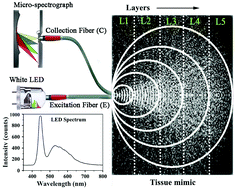Picosecond-resolved fluorescence resonance energy transfer (FRET) in diffuse reflectance spectroscopy explores biologically relevant hidden molecular contacts in a non-invasive way
Abstract
The potentiality of Förster resonance energy transfer (FRET) for studying molecular interactions inside biological tissues with improved spatial (Angström) and temporal (picosecond) resolution is well established. On the other hand, the efficacy of diffuse reflectance spectroscopy (DRS) that uses optical radiation in order to determine physiological parameters including haemoglobin, and oxygen saturation is well known. Here we have made an attempt to combine diffuse reflectance spectroscopy (DRS) with picosecond-resolved FRET in order to show improvement in the exploration of molecular contacts in biological tissue models. We define the technique as ultrafast time-resolved diffuse reflectance spectroscopy (UTRDRS). The illuminated photon of the fluorophore from the surface of the tissue-mimicking layers carries the hidden information of the molecular contact. In order to investigate the validation of the Kubelka–Munk (KM) formulism for the developed UTRDRS technique in tissue phantoms, we have studied the propagation of incandescent and picosecond-laser light through several layers of cellulose membranes. While picosecond-resolved FRET in the diffuse reflected light confirms the hidden nano-contact (4.6 nm) of two different dye layers (8-anilino-1-naphthalenesulfonic acid and Nile blue), high-resolution optical microscopy on the cross-section of the layers reveals the proximity and contacts of the layers with limited spatial resolution (∼300 nm). We have also investigated two biologically relevant molecules, namely carboxyfluorescein and haemoglobin, in tissue phantom layers in order to show the efficacy of the UTRDRS technique. Overall, our studies based on UTRDRS in tissue mimicking layers may have potential applications in non-invasive biomedical diagnosis for patients suffering from skin diseases.



 Please wait while we load your content...
Please wait while we load your content...